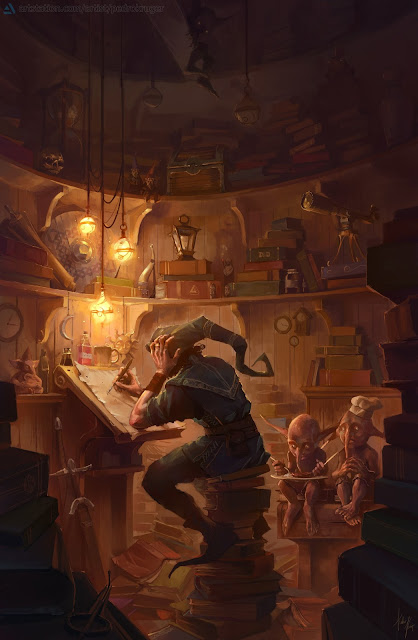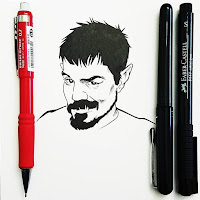I think as artists, it's important that we all build community. That we build a support system of people that we can lean upon. A moment to realize that no question is too big or two small. This brings me to today's question:
(My Little Corner by Pedro Krüger Garcia)
Why Creativity?
"Is this what I (we) really want to do?"This question, much like a disc that continually skips, was on repeat. I feel like a majority of artists are initially scrambling to find a reason to do what they do, or even do what they enjoy.
I think it's critically important to discover why you enjoy art in the first place. That will be the initial guiding light that will turn you towards what you'd like to push forward with.
Ask yourself: What am I interested in?
This can seem like a daunting question at face value, but it will help to quickly turn the tide in your self-discovery favor.
I can still remember it, when I was a kid, thumbing through old volumes of Advanced Dungeons and Dragons, 2nd ed. Monsters Manual. I would read the small descriptions, even before looking at any of the ink plates that were presented in the book itself, and try my damnedest to imagine what the creatures would look like before I took a peek. Usually I was wrong, but I learned a valuable lesson at that point. I have the ability to come up with my own monsters? That's a thing?! It took a long while for this ideology to sink in, but there you have it, my first steps into doing art as a profession. Of course, I didn't know it at the time, but that for another story.
Fast-forward some time and thousands-upon-thousands of images later (not my own creation, merely gathered imagery), and I have slowly begun to discover what types of images I do or don't like. Some might say, I've gained a tad of an Art Director's eye. I can go on, at length, as to what makes a piece of art good or bad and offer a multitude of fixes to help make the piece really shine!
But through all of it, I still get continually asked the same question about creativity.
There isn't of course a tell-tale answer for everyone, but here's a few reasons that I think some people might pursue the creative arts:
For Money?
Some people might merely be searching for the next paycheck. While I will admit, sometimes the instant gratification of a payday can seem like a heaven-sent, I think it's important to look at the bigger picture. Sure, we all need money, but there's a certain amount of soul-gratification to completing a piece. I have this tendency to save a piece in a multitude of stages from initial sketch to final piece. I think this might be a holdover from when I was back in art school, but it's extremely gratifying to look back at a piece from conception to final.
Another bonus to saving a piece in stages, especially if you're searching for the monetary aspect, is that you can double it up later on as part of an art book. I know that I, for one, love to see all of the stages that make up the end result.
For Prestiege?
While this is something that typically happens over-time, some people go into the arts with this purely in mind. Going for fame and glory is always a matter of opinion, but having a background task (typically) is the way of the artist. There's always the ability to gain some sort of fame, or notoriety, depending on how you pursue your creativity, but there's still a certain amount of letting your creations speak for you. In this regard, I think that jumping into creativity with this in mind might end up making your struggle a bit harder than intended up front.
I'd suggest to let this path come to you.
For Preservation?
This one is also a bit hard to gauge because, as with prestige, usually comes the need for a way for your audience to want in on the action. By default, then, you end up with a sort of living legacy of your work.
For example, go back and look at a piece you did long ago, and then compare it to a piece that you're currently working on. I'd guarantee that you'll see a huge difference, even if it's only been a short amount of time. Your mind has changed about things, or perhaps your skill has grown. Ultimately, preservation, and subsequently, the need for collectors, will grow over time.
For Fun?
Then we come upon the real reason we should all be creating in the first place. FUN. If you're not enjoying the path as your developing it, trust me, it shows. I've seen the most passionate people burn out simply because they lost sight of the ability to have fun with their work.
If you're finding yourself burned out, try doing something completely different artistically. Drawing too many dragons? Try going the opposite direction: draw some robots. Combine the two: robotic dragons. Feeling out of sorts with character design? Try a couple environment studies. Another important thing to try is... simply take a break! Most people think that they have to grind and grind to get to their goals. Well when gears grind too hard, they break. This is true for a creative. They need to take a step back sometimes and just refresh their batteries.
I make it a point whenever I finish a big commission to take a day or two to just push that refresh button. Watch movies, play games, listen to music non-stop; anything that provides a release from monotony.
Ultimately, just have fun with your work!
-----
There are many other reasons to pursue art, but these are the top four that come to mind instantly whenever I start to think about reasons behind the art.
What are some of your reasons for continuing to make work? Leave a comment below with yours!



































